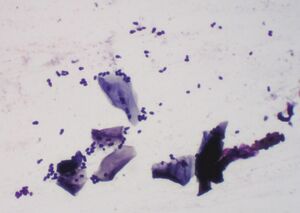Malassezia equina
Classification
Eukaryota; Basidiomycota; Malasseziomycetes; Malasseziales; Malasseziaceae
Species
|
NCBI: [1] |
Malassezia equina
Description and Significance
Malassezia equina is an ovoidal shaped fungus that partakes in the microflora of the skin and cause opportunistic diseases in horses. This organisms coexists with the skin of the host without any damage, unless an opportunity comes such as an open wound. (Gaitanis et al., 2012; Wikipedia contributors, 2022). Malassezia equina needs lipids to grow so the optimal place for them to grow is lipid rich areas of the horses body where there are lots of sebaceous glands. (Theelen et al., 2018)
This is an important microbe to understand as it helps scientist understand different skin disorders and how it affects animals as well, in this scenario horses. Studying this disease can better research in related species that cause similar disease. Studying M. equina can also help develop better treatment for the skin conditions that it causes.
Genome Structure
Malassezia equina has 4109 genes. Malassezia species have 6 to 9 chromosomes. The genome has a linear structure due to it being a Eukaryote. It grows best between 32 and 37 degrees Celsius.
Cell Structure, Metabolism and Life Cycle
Malassezia species have lipophilic properties, meaning they gain energy form lipids. They breakdown the lipids found on the surface of the skin, such as fatty acids and triglycerides found in sebum. (Celis Ramirez et al., 2020) M. equina produces azelaic acid, which hunts for free radicals. It also produces a mycelial form and a large range of metabolites, including lactone which can is the reason why the cultured fungus has a fruity scent. (Chester, 2011)
Ecology and Pathogenesis
Malassezia equina lives in the skin of horses and it is distributed where sebaceous glands are more prominent. Usually M. equina has a commensal symbiosis with its host. They tend to produce no harm under normal circumstances. This microbe can become pathogenic and cause opportunistic disease if there has been a compromise of the immune system and the pathogen found a way to infect the host.
Malassezia equina has biogeochemical significants since it can be argued that by them metabolizing with lipids, they are recycling organic matter that is int he environment. They contribute to the environment by being part of the skin's microflora. An environmental adaptation this yeast had to go through was becoming dependent in lipids for their energy. This is because the skin of animals are a lipid rich environment, therefore they need to adapt to make use of that resource.
This organism causes disease on its host only when there is damage to the skin. Malassezia equina can cause inflammation and pruritus, or itching, by having the M. equina enzymes target the keratinocytes in the skin. By doing this, it activates both the humoral and the cell-mediated host immune response. (10)
References
Gaitanis G, Magiatis P, Hantschke M, Bassukas ID, Velegraki A. The Malassezia genus in skin and systemic diseases. Clin Microbiol Rev. 2012 Jan;25(1):106-41. doi: 10.1128/CMR.00021-11. PMID: 22232373; PMCID: PMC3255962.
Wikipedia contributors. Malassezia equina. In Wikipedia, The Free Encyclopedia. 2022, November 18; https://en.wikipedia.org/w/index.php?title=Malassezia_equina&oldid=1122549191
Theelen B, Cafarchia C, Gaitanis G, Bassukas I D, Boekhout T, Dawson T L, Malassezia ecology, pathophysiology, and treatment, Medical Mycology, 2018 April; 56(1) S10–S25. https://doi.org/10.1093/mmy/myx134
Celis Ramírez AM, Amézquita A, Cardona Jaramillo JEC, Matiz-Cerón LF, Andrade-Martínez JS, Triana S, Mantilla MJ, Restrepo S, Barrios AFG, de Cock H. Analysis of Malassezia Lipidome Disclosed Differences Among the Species and Reveals Presence of Unusual Yeast Lipids. Front Cell Infect Microbiol. 2020 Jul 15;10:338. doi: 10.3389/fcimb.2020.00338.
Chester C, Yeasts Pathogenic to Humans. The Yeasts. 2011; 5(2):9-19. https://doi.org/10.1016/B978-0-444-52149-1.00002-1.
Funiciello B, Bannoehr J, Malessezia dermatitis, Equis, n.d. https://www.vetlexicon.com/equis/dermatology/articles/malassezia-dermatitis/
Author
Page authored by Liz Betancourt, student of Prof. Bradley Tolar at UNC Wilmington.
Winner: 2023 People's Choice Award (tie)

